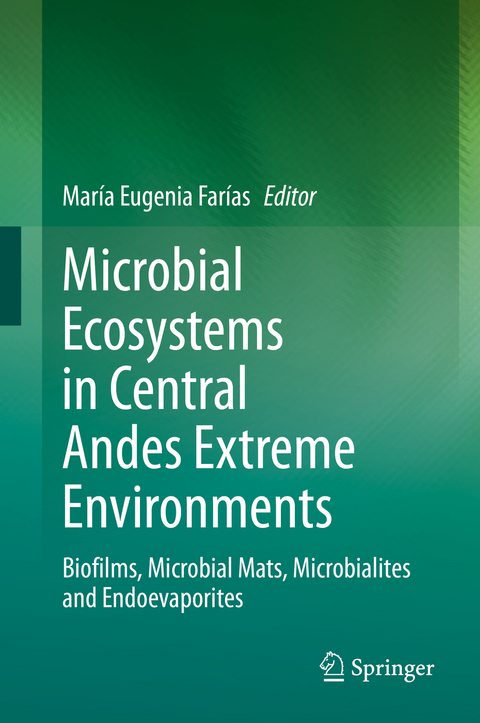
Microbial Ecosystems in Central Andes Extreme Environments
Springer International Publishing (Verlag)
978-3-030-36194-5 (ISBN)
lt;p>
Dr. María Eugenia Farías graduated with honors in Biology at the Universidad Nacional de Tucumán and obtained her PhD in Microbiology from the same institution followed by a postdoctoral at the Centro de Investigaciones Biológicas (CIB - CSIC) in Madrid. In 2003 she created the Laboratory of Microbiological Research in Andean Lagoons (LIMLA) dedicated to the study of the microbiological biodiversity of the lagoons, salt pans and volcanoes of the Argentinean Puna. In 2009, she discovered microbial ecosystems in the region and since then, through intense scientific activity and dissemination, she has been promoting activities aimed at protecting extremophile ecosystems in the context of mining activity in the region. She was involved in the creation of a Protected Area in Socompa and created the first collection of endangered microorganisms and metagenomas of the Andean Extremophiles ecosystems (algae, archaea, bacteria and fungi). Besides her many research article publications, she was also mentioned in the L'Oreal -UNESCO for woman in Science award in 2011 and is currently doing a Surveying of extreme microbial ecosystems associated with minerals (microbialites, microbial mats, and endoevaporites) in Central Andes, of Argentina, Chile, and Bolivia.
Section I - General considerations.- Chap 1 - Introduction Maria Eugenia Farias (LIMLA, Argentina).- Chap 2 - Origin and evolution of the central Andes: deserts, salars lakes and volcanoes R.Alonso (U. Nacional de Salta, Argentina) and W. Rojas (Eramine Sudámerica S.A., Argentina).- Chap 3 - Modern microbilies mats and endovaporite system in Andean lakes: a general approach Maria Eugenia Farias (LIMLA, Argentina).- Section II - Preandean and andean atacam desert: life at limits.- Chap 4 - Desert polyextreme environment and lithobiontic habitats J. Wierzchos, C. Ascaso, O. Artieda and M.C. Casero (Museo Nacional de Ciencias Naturales, Spain).- Chap 5 - Desert microbiology J. Di Ruggiero (Johns Hopkins University, USA) and M.C. Casero (Museo Nacional de Ciencias Naturales, Spain).- Chap 6 - Desert biosignatures P. Vitek (The Czech Academy of Sciences, Czech Republic) and J. Wierzchos (Museo Nacional de Ciencias Naturales, Spain).- Chap 7 - Microbial characterization of Andean Vega's soil C. Belfiore, M.E. Farias (LIMLA, Argentina) and M. Contreras (Centro de Ecología Aplicada, Chile).- Section III - Life in Andean Volcanoes and Fumaroles.- Chap 8 - Limits to microbial life at the altitudinal and dry extremes for life on Earth at Llullaillaco and Socompa Volcacones S. Scmidt and P. Sowell (University of Colorado, USA).- Chap 9 - The biogeochemistry of microorganisms in the geothermal features of El Tatio Geyser Field, Chile K.D. Myers (Columbia University, USA), A.S. Angel (University of Tennessee, USA) and P.C. Bennett (The University of Texas at Austin, USA).- Chap 10 - The unique holoarchea dominated biofilms associated Diamante Lake inside Galan Volcanoes Microbialites N. Rascova (Aix Marseille Université, France) and M.E. Farias (LIMLA, Argentina).- Section IV - Endoevaporites and Mats in Salars and Wetlands.- Chap 11 - Endoevaporites dominated by Arquea at Laguna Tebenquiche M.C. Rasuk (LIMLA, Argentina), Pieter V. (University of Connecticut, USA), A.B. Fernández (University of Sevilla, Spain) and M.E. Farias (LIMLA, Argentina).- Chap 12 - Rare microbial biosphere in Salar de Huasco: hyperdiversity in polyextreme aquatic ecosystem C. Dorador, N. Miranda, V. Ávalos (Universidad de Antofagasta, Chile), V. Molina (Universidad de Playa Ancha, Chile) and M. Hengst (Universidad Católica del Norte, Chile).- Chap 13 - Microbiome of evaporites and microbial mats in the Salar de Llamara, Atacama desert M. Rasuk and M.E. Farias (LIMLA, Argentina).- Chap 14 - Microbial diversity in athalassohaline Argentinean salterns M.R. Mora-Ruiz and R. Rosselló-Móra (Mediterranean Institute for Advanced Studies, Spain).- Section V - Microbialites at lakes.- Chap 15 - Physicochemical and microbiological processes in carbonate precipitation in hypersaline lakes: the laguna Negra case F.J. Gomez (Centro de Investigaciones en Ciencias de la Terra, Argentina), L.C. Kah (University of Tennessee, USA), C. Mlewski, F.J. Boidi (Centro de Investigaciones en Ciencias de la Terra, Argentina) and E. Gerard (Université Paris Diderot, France).- Chap 16 - Microbialites Laguna Socompa V. Albarracin and M.E. Farias (LIMLA, Argentina).- Chap 17 - Microbialites oncolites and mats at Laguna La Brava P. Visscher (University of Connecticut, USA), M. Contreras (Centro de Ecologia Aplicada, Chile) and M.E. Farias (LIMLA, Argentina).- Chap 18 - Modern microbiolites of Pozo Bravo lake, Salas de Antofalla, Antofagasta de la Sierra, Catamarca A.I. Lencina, M.N. Soria (PROIMI, Argentina), R. Palma (Universidad de Buenos Aires, Argentina) and M.E. Farias (LIMLA, Argentina).- Section VI - Extremolites: microbes surviving in Andean microbial ecosystems.- Chap 19 - Light sensing and mechanisms of adaptation to high solar irradiation V.H. Albarracín, M. Gorriti, L. Portero, F. Zannier (PROIMI, Argentina), W. Gärtner (Max Planck Institute, Germany) and M.E. Farias (LIMLA, Argentina).- Chap 20 - Linear megaplasmids spreading the Andean Resistome M.F. Perez and J.R. Dib (LIMLA, Argentina).- Chap 21 - Arsenic: Not as bad as it sounds Visscher (University of Connecticut, USA), Gallagher, Contreras (Centro de Ecologia Aplicada, Chile), Farias (Universidad Nacional de La Plata, Argentina), Philippot (Univesité Paris Diderot, France), Sancho-Tomas and Somogyi (Synchroton Soleil, France).- Section VII - Prospecting and protecting singular ecosystems.- Chap 22 - Conservation of extremophile communities in complex ecosystems M. Contreras (Centro de Ecologia Aplicada, Chile).- Chap 23 - Integral prospection of Andean Microbial Ecosystem Project M.E Farias (LIMLA, Argentina).- Index.-
| Erscheinungsdatum | 30.05.2021 |
|---|---|
| Zusatzinfo | XXIV, 292 p. 62 illus., 54 illus. in color. |
| Verlagsort | Cham |
| Sprache | englisch |
| Maße | 155 x 235 mm |
| Gewicht | 483 g |
| Themenwelt | Naturwissenschaften ► Biologie ► Ökologie / Naturschutz |
| Schlagworte | Andean Microbial Ecosystem project • Andean Microbiology • Desert microbiology • Extremolytes • extremophiles • High Altitude Ecology • microbial ecology |
| ISBN-10 | 3-030-36194-2 / 3030361942 |
| ISBN-13 | 978-3-030-36194-5 / 9783030361945 |
| Zustand | Neuware |
| Haben Sie eine Frage zum Produkt? |
aus dem Bereich


